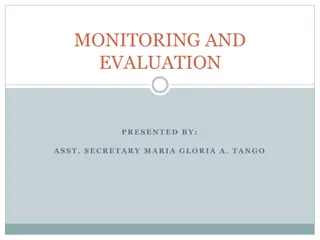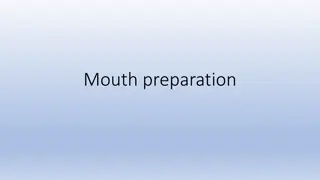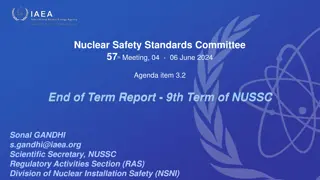IAEA Safety Standards Development Process: SPES.B Step-by-Step Review and Preparation
In the development process of IAEA Safety Standards, the SPES.B step-by-step approach is outlined, detailing the preparation and review stages for NSOC Safety Standards and Security Guidance. The process manual provides a comprehensive guide with 14 steps, including inputs and outputs, for the review of draft Nuclear Security Series Publications. It emphasizes knowledge management, value-added activities, and timeframes for each step, culminating in publication approval. Review committees play a vital role in the basic process, ensuring thorough evaluation before final endorsement.
Download Presentation

Please find below an Image/Link to download the presentation.
The content on the website is provided AS IS for your information and personal use only. It may not be sold, licensed, or shared on other websites without obtaining consent from the author.If you encounter any issues during the download, it is possible that the publisher has removed the file from their server.
You are allowed to download the files provided on this website for personal or commercial use, subject to the condition that they are used lawfully. All files are the property of their respective owners.
The content on the website is provided AS IS for your information and personal use only. It may not be sold, licensed, or shared on other websites without obtaining consent from the author.
E N D
Presentation Transcript
IAEA safety standards: SPESS B step-by- step process for preparation and review NSOC Safety Standards and Security Guidance Development Section Presentation for Review Committees: 2024
Step-by-step process Manual for the review process for draft Nuclear Security Series Publications and for the Application of SPESS A for the IAEA Safety Standards (SPESS B) 14 steps with Inputs and Outputs Each actor and their function Knowledge management, value added, minimum time for each step Version 3.3 - 23 May 2023 62 pages, including 6 annexes 2
Process flow Outline and work plan (DPP) Planning Steps 1-4 CC, Committee and CSS approval of DPP Drafting or revising Drafting Steps 5-8 CC and Committee approval of draft Review and comment by Member States Revision of draft to address MS comments Refining Steps 9-11 CC and Committee approval of final draft Editing and CSS endorsement Approval by DDG-NS and editing Finishing Steps 12-14 Establishment by DG or BoG Endorsement by DG or BoG Publication 3
Review Committees: the basic process 1. DPPs/drafts submitted >2 months before meetings Posted on website for comments ( Drafts for Comment ) 2. Comments from Committees to be posted >3 weeks before meetings 3. Comment resolution posted >1 week before meetings 4. DPP/draft and comment resolution presented by Technical Officer at the meetings 5. Technical Officer addresses comments after the meetings Any conflicting comments between Committees are addressed by Chairs after the meetings 4
Planning: Steps 1 - 4 Preparing the DPP Step 1 Review of the DPP by the Coordination Committee Verification by the Interface Group Step 2 Step 3 Review of the DPP by the Review Committees Step 4 Review of the DPP by the Commission on Safety Standards 5
Step 3: review of the DPP Purpose of Step 3 review is to consider: Is the title appropriate? Which Review Committees should be involved? Who are potential cosponsors? Why do we need to address this specific topic? Why do we need this specific publication? How does this fit with other publications in the series? What is the scope? Who is the target audience? What will this publication achieve? Problems left unaddressed at the DPP stage are much more difficult to resolve later 6
Drafting and Revising Preparing the draft Step 5 Review of draft by Coordination Committee Step 6 Step 7 First review of draft by Review Committees Step 8 Soliciting MS comments on draft [120+ days] 7
Step 7: First review of the draft by the Review Committees Purpose of Step 7 review is to consider: Is the draft consistent with the DPP? Are the objective and scope addressed properly? Is the draft good enough to be sent to MS? consider the technical accuracy, overall flow and level of detail For interface documents: Could the security measures in draft NSS publications compromise safety? Step 7 is the last opportunity for any major changes to the draft text Please no editorial comments This is the step at which comments should be provided by observer organizations 8
Refining: Steps 9 11 Step 9 Addressing Member State comments Review by Coordination Committee Standards Specialists Review Step 10 Second review of draft by Review Committees Step 11 9
Step 10: Standards Specialists Review Purpose is to check: Consistency Within the publication With other publications With rules for the Series and SPESS Clarity for the intended audience, not the drafters Terminology consistency with the Glossary Adherence to Agency s corporate style 10
Step 11: Second review of the draft by Review Committees For drafts submitted at Step 11 you will see: A comment resolution table of all MS comments An updated draft, incorporating MS comments, which has been reviewed by a Standards Specialist Purpose of Step 11 review is to consider: Have MS comments been adequately addressed? Do we have consensus? Is the final quality good enough? Step 11 is too late to introduce new issues or change direction And again, please no editorial comments! Please avoid drafting new text in meetings 11
Finishing: Steps 12 - 14 Endorsement by the CSS Approval by the Publications Committee Editing and layout by MTCD Step 12 Step 13 Approval by the Board of Governors [Requirements/Fundamentals only] Step 14 Publication 12























